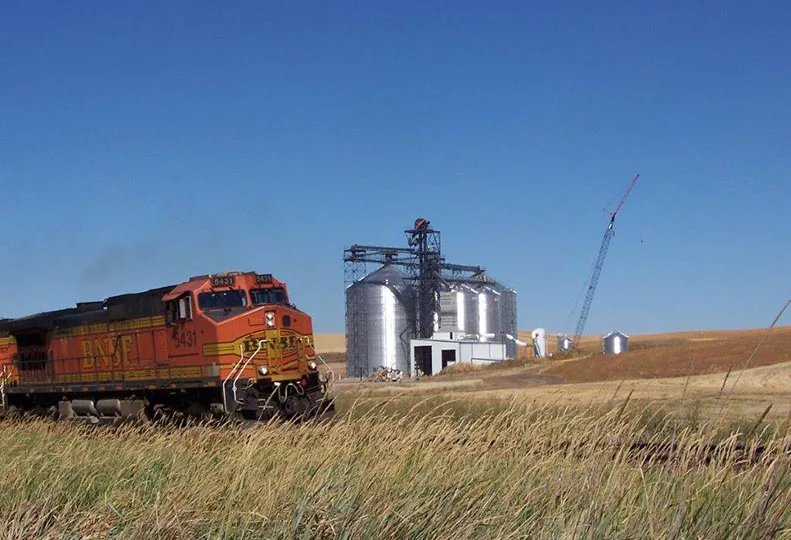$17 million grain elevator complex gears up south of Spokane
Terminal south of Spokane begins to load some wheat; geared to fill 110 railcars

A newly constructed $17 million grain-handling terminal near Rosalia is starting to load wheat into railcars for export, and the facility is expected to ramp up later this year to capacity, handling about 300,000 bushels a day of incoming product.
"We've had some activity moving grain during the last three weeks," says Dick Hatterman, general manager of Rosalia-based Cooperative Agricultural Producers Inc., a co-owner of the new McCoy Grain Terminal along with Pacific Northwest Farmers Co-op, of Genesee, Idaho.
Hatterman adds, "It's a large facility with various items that need to mesh together, and we're working to get everything to mesh. It's going pretty well. We'll be having incoming grain, as well as rail being loaded with grain for transportation to Portland for export."
In 2012, the two farm cooperatives began constructing the terminal on about 160 acres to include just over two miles of railroad loop track, laid in a tear-shaped configuration, to accommodate a 110-car freight shuttle train with four engines.
The facility's equipment can load grain into the railcars at a rate of 60,000 bushels an hour, though Hatterman says the facility won't be running at that rate consistently during a typical work day.
He says the terminal's equipment also will be unloading grain at a rate of 40,000 bushels an hour as shipments arrive at the McCoy facility via trucks and smaller-quantity railcars originating from Inland Northwest grain elevators and farms.
"It's hard to run it at capacity for a full day," he says, adding that the McCoy terminal can load and unload grain at the same time but won't necessarily be handling both functions simultaneously.
The facility is located along State Route 271, about 35 miles south of Spokane and 4 miles east of Rosalia. The Haskins Co., of Spokane, and Railworks Track Systems Inc., of Chehalis, Wash., are the contractors on the project. HDR Engineering Inc., of Spokane, participated in the design.
The McCoy terminal's railroad track connects to what is called the P&L shortline near McCoy, Wash. The shortline then leads to the main line of Burlington Northern Santa Fe Railway at Marshall, Wash., about 10 miles southwest of Spokane, for eventual West Coast export of the wheat.
Although the railroad loop track and grain-loading equipment are in place, some site work at McCoy is just wrapping up, says Bud Riedner, the terminal's manager, who is among four full-time employees currently working at the site.
"It's a new construction project, so a lot of the grain we've taken in so far has been experimental to see how well it works," Riedner says. "We should be doing a partial loading at the end of the week (Oct. 11)," which means filling 50 to 60 rail cars, as a step prior to full-capacity loading in a few weeks.
Riedner adds, "Hopefully, between Oct. 15 and 20, we'll try to do the first (full) shuttle train out of McCoy terminal. McCoy will be full speed by the end of October, and then it depends on the market as far as how much we move."
Riedner says that while the facility is expected to be fully geared up soon, the wheat market can be sluggish in October because West Coast storage elevators typically concentrate more on soybean and corn markets at this time of year.
"When we get up to full capacity, we'd like to dump about 800,000 bushels a week, and about 800 trucks a week," he says. "The market is cyclical, and exports will be a little slow for wheat in October, but we should be reaching full stride in late December, January, and February."
Riedner says the initial operation of equipment at the McCoy Grain Terminal has gone well, adding that the facility has a sophisticated automated system that includes electronic sensors.
Hatterman says the sensors can read a radio frequency identification tag located on each railcar. Such technology incorporates radio-frequency electromagnetic fields to transfer data.
"Our system can read that radio frequency identification and know you can put 'X' amount on a car," he says.
Hatterman says grain will arrive at the McCoy terminal primarily on trucks coming in from farms and from grain storage elevators from as far away as north of Pullman. The facility also will receive shipments from farms and elevators just north of McCoy, from a range of about 15 miles, he says.
Other grain supplies will arrive at McCoy via a few railcars that are loaded with wheat at storage elevators, including elevators owned by the two cooperatives and others independently owned, which are located along the P&L shortline, he adds.
Hatterman says the two agricultural co-ops built the McCoy Train Terminal to meet the requirements of the railroad transportation system today that predominately includes use of 110-railcar shuttle trains for freight shipments.
"The rail system has evolved," he says, adding that early-day operations involved loading wheat into bags that were put into rail cars, until loading into bulk hopper cars was developed for greater efficiency. "It's now evolved that the main method of transportation on the rail system is with a 110-car shuttle," as opposed to using between 25 and 75 railcars.
The McCoy Terminal also can store up to 1.3 million bushels of wheat in grain storage tanks built on site, but that capability is meant mainly for temporary storage, typically held two weeks to four weeks at the most, Hatterman says.
"The majority of wheat produced in the Inland Northwest is destined for export, so any storage is temporary," Hatterman says. "It's shipped out in fairly rapid fashion."
The terminal operation is complementing a secondary system in place to ship wheat via river barges along the Columbia-Snake river system, Hatterman says.
"We will be shipping by barge also," he says. "Our (farm co-op) companies are owners or part owners of three barge-loading facilities along the Snake River, for transport ultimately to Portland along the river system."
The Pacific Northwest Farmers Co-op says on its website that its membership exceeds 750 Inland Northwest agricultural producers who grow wheat, peas, and other crops. Cooperative Agricultural Producers says it has 640 farmer members who are shipping wheat, barley, pea, and lentil products.
Hatterman says the two cooperatives expect to benefit from cost-savings over time with the McCoy terminal because railroad operators charge producers and shippers lower rates when loads are transported on shuttle trains.
The 110-railcars remain connected during loading and shipment, which means that railroad operators don't lose time handling and consolidating smaller numbers of rail cars into a single trainload, and therefore charge lower shipment rates, he adds.
"The freight costs to ship by shuttle are less than what the cost is to ship by single cars, or by 25 cars," he says. "For anything less than a shuttle train, the cost per bushel goes up. We're able to ship at lower cost, so that cost is spread out over more bushels."
Related Articles

_c.webp?t=1763626051)


